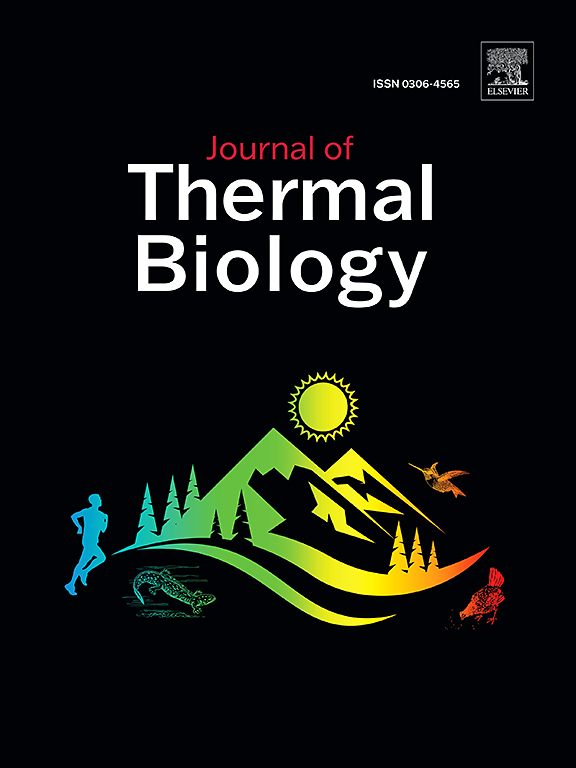卵发育过程中的热浪会改变欧洲蠼的母体护理和后代质量。
IF 2.9
2区 生物学
Q2 BIOLOGY
引用次数: 0
摘要
气候变化会降低动物的存活率、生育能力和繁殖力,并改变后代的发育和存活率,从而破坏动物的健康。虽然亲代照料通常有助于后代应对恶劣的环境条件,但人们对亲代照料在缓冲热浪等极端温度变化方面的作用知之甚少。在这项研究中,我们测试了亲代关怀是否能减轻寒冷和热浪对欧洲蠼卵和幼虫的影响。在这种昆虫中,母虫在冬季通常在 10 °C左右的温度下对卵进行约 50 天的强制性照料。我们在产卵后15天和30天将母虫及其卵暴露于3 °C、10 °C(对照)、17 °C或24 °C的三天热浪中。然后,我们测量了四种母体照料行为、母体体重变化以及卵的发育时间、存活率和孵化率。我们测量了幼体的体重、发育时间、抗热性以及六种热应激和免疫基因的表达。我们发现,热浪减少了母性照料,并导致母性体重增加。高温还降低了卵的孵化成功率,加速了卵和若虫的发育,降低了幼体的热上限,减少了一种热休克蛋白(Hsp68)的表达,而其他性状则不受影响。总之,这项研究强调,在欧洲蠼的卵发育过程中,获得母体照顾不足以减轻暴露在非最佳温度下的压力。该研究还表明,有母性关怀的物种不一定能获得有效的热保护,也不一定能更好地适应气候变化。本文章由计算机程序翻译,如有差异,请以英文原文为准。
Heat waves during egg development alter maternal care and offspring quality in the European earwig
Climate change can disrupt animal fitness by reducing survival, fertility, fecundity and altering offspring development and survival. While parental care typically helps offspring cope with harsh environmental conditions, little is known about its role in buffering extreme temperature changes, such as heat waves. In this study, we tested whether parental care mitigates the impact of cold and heat waves on eggs and juveniles in the European earwig. In this insect, mothers provide obligatory egg care for about 50 days during winter, typically at temperatures around 10 °C. We exposed mothers and their eggs to three-day thermal waves of 3 °C, 10 °C (control), 17 °C or 24 °C, both 15 and 30 days after oviposition. We then measured four maternal care behaviors, maternal weight variation, as well as eggs’ developmental time, survival, and hatching rate. In the resulting juveniles, we measured weight, developmental time, thermal resistance, and the expression of six heat stress and immunity genes. We found that thermal waves reduced maternal care and induced maternal weight gain. High temperatures also decreased egg hatching success, accelerated egg and nymph development, reduced the upper thermal limit of juveniles and decreased the expression of a heat shock protein (Hsp68), while other traits remained unaffected. Overall, this study highlights that access to maternal care is not enough to alleviate the stress of exposure to non-optimal temperatures during egg development in the European earwig. It also suggests that species with maternal care do not necessarily have access to effective thermal protection and may not be better adapted to climate change.
求助全文
通过发布文献求助,成功后即可免费获取论文全文。
去求助
来源期刊

Journal of thermal biology
生物-动物学
CiteScore
5.30
自引率
7.40%
发文量
196
审稿时长
14.5 weeks
期刊介绍:
The Journal of Thermal Biology publishes articles that advance our knowledge on the ways and mechanisms through which temperature affects man and animals. This includes studies of their responses to these effects and on the ecological consequences. Directly relevant to this theme are:
• The mechanisms of thermal limitation, heat and cold injury, and the resistance of organisms to extremes of temperature
• The mechanisms involved in acclimation, acclimatization and evolutionary adaptation to temperature
• Mechanisms underlying the patterns of hibernation, torpor, dormancy, aestivation and diapause
• Effects of temperature on reproduction and development, growth, ageing and life-span
• Studies on modelling heat transfer between organisms and their environment
• The contributions of temperature to effects of climate change on animal species and man
• Studies of conservation biology and physiology related to temperature
• Behavioural and physiological regulation of body temperature including its pathophysiology and fever
• Medical applications of hypo- and hyperthermia
Article types:
• Original articles
• Review articles
 求助内容:
求助内容: 应助结果提醒方式:
应助结果提醒方式:


